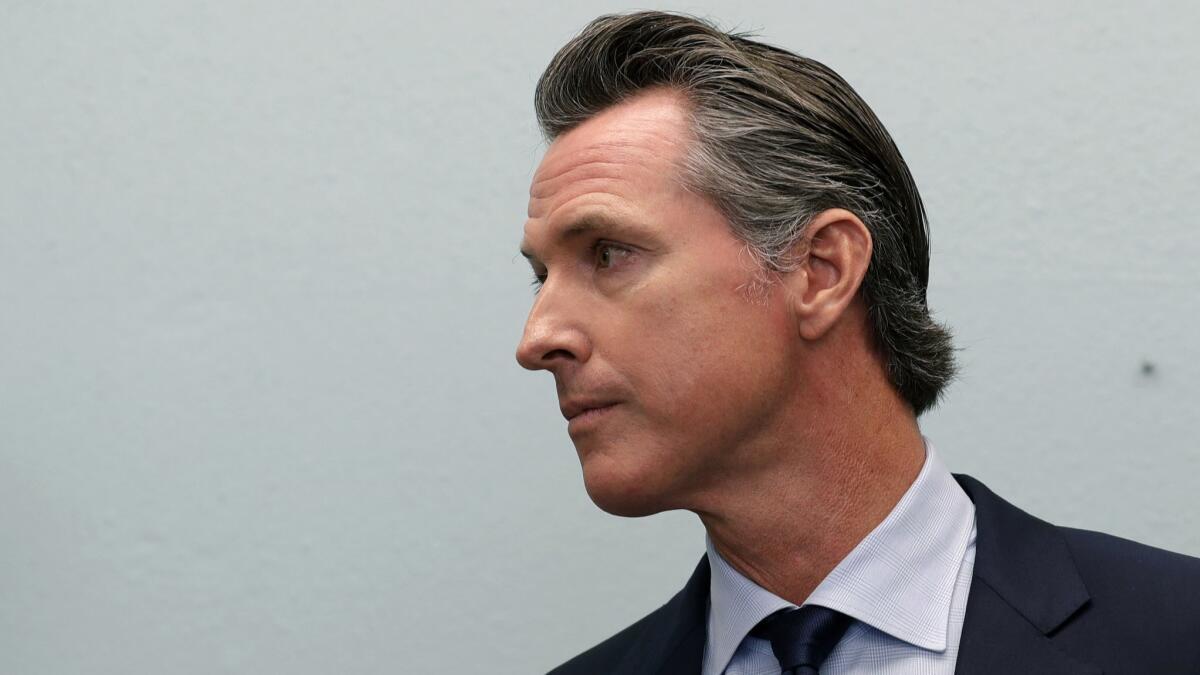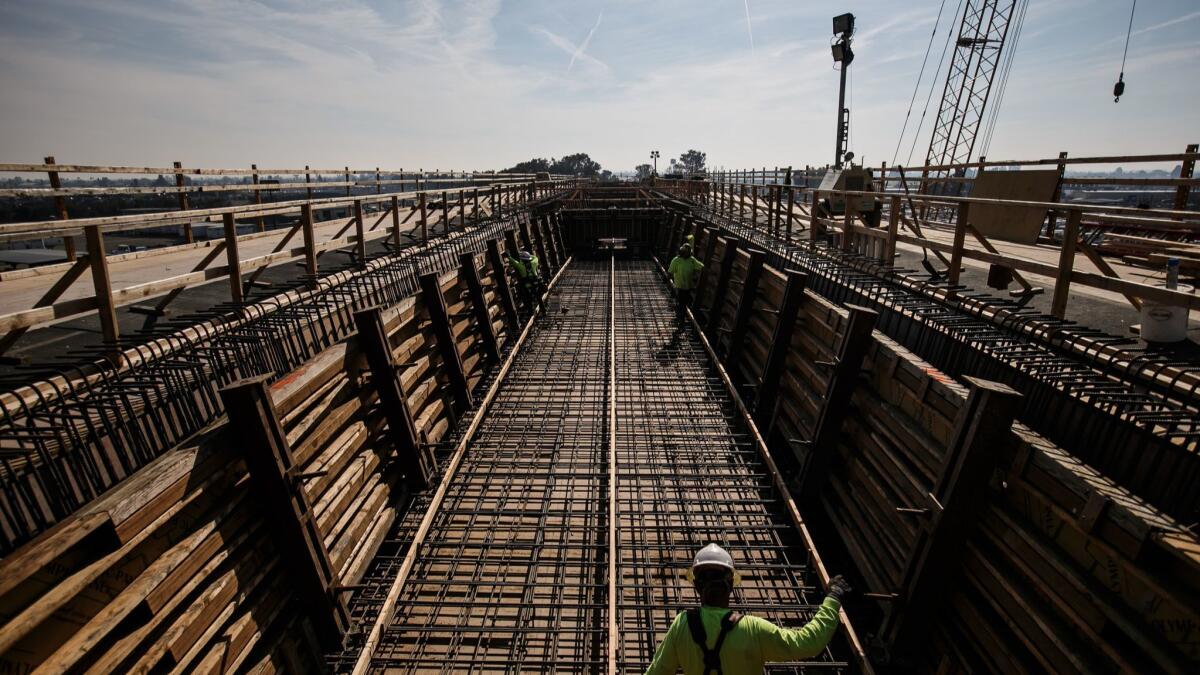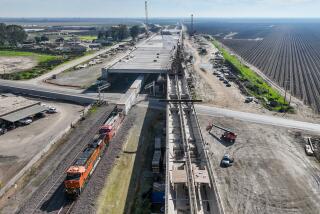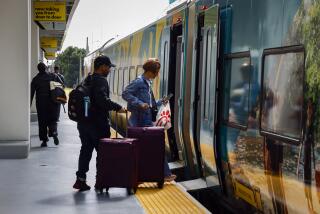Among the headaches Gavin Newsom will inherit as governor: California’s troubled bullet train project

Gov. Jerry Brown has devoted half a century of political knowledge and power to advance the California bullet train construction project, but he leaves office with its future badly damaged by cost overruns, mismanagement and delays.
It hands incoming Gov. Gavin Newsom a tough decision: delay indefinitely the goal of a statewide bullet train system and salvage something useful out of the billions of dollars already spent, or stick with the original vision and find at least $50 billion in new money to keep it going.
Either option will probably lead to a clash between the project’s die-hard supporters and its skeptics. Almost every major engineering and construction firm has a big stake in the project, as do unions, small businesses and city governments. The outcome will depend on how much fiscal pain and risk Democrats are willing to accept.
So far, Newsom has only hinted at what he will do, saying at times the effort must continue in some form — though with less gusto than Brown exhibited as he championed what has grown into the nation’s largest infrastructure effort over the last eight years.
Newsom, who declined interview requests, has his own alternative big-ticket priorities: universal healthcare, early childhood education, homelessness and climate change. None of them involve the $77-billion rail project.
Interviews with more than a dozen California officials, construction executives, engineers and academics who study transportation say the project’s problems go so deep that the state will probably have to settle for something far less than the original blueprint of a high-speed rail network through almost every major city from Sacramento to San Diego — at least until the middle of the century or later.
“If I was going to teach my students how not to build a high-speed rail, the California system would be the lesson,” said Bent Flyvbjerg, a University of Oxford professor who has studied bullet trains around the world and is widely considered one of the top experts on mega-project risk. “It is a long shot to be highly successful.”
The problems, to be sure, do not preclude finishing the system, Flyvbjerg said. Experts close to the project estimate future costs could be covered roughly by a 20-cent-a-gallon gas tax or a half-cent sales tax or a 6% state income tax surcharge — though any of those would be a huge lift for Newsom and other Democrats focused on other progressive issues.
The California High-Speed Rail Authority has enough money to keep going for two to four years before it could exhaust its cash stockpile, depending on the flow of state funding and whether costs continue to increase. But time is the project’s enemy, as inflation adds $1 billion to $2 billion to the project’s cost for every year of delay.
Though the bullet train won the support of voters in 2008 and remains popular among Newsom’s constituency, cracks are beginning to emerge in the unconditional support Brown had engendered among Democrats. Republican opponents generally want an outright cancellation.
Assembly Speaker Anthony Rendon (D-Lakewood) said in an interview he wants the project paused for a reassessment. Assemblyman Jim Frazier (D-Oakley), chair of the Transportation Committee, has called for the resignation of rail authority Chairman Dan Richard. Newsom has said he wants to revise the project in some undefined way, and people close to the project anticipate he might replace some of Brown’s executives and board appointees with his own staff.
Rendon cites concerns about its cost and schedule and that the benefits will not reach the state’s major population centers in the south.
“We need a timeout,” he said. “We need to hit the pause button and make a careful judgment about the next steps. I do have a sense of urgency. To evaluate the project while it is ongoing is difficult. We need to look at the direction being taken. It is not at all what the voters approved.”
The authority is currently building 119 miles of track and structures in the Central Valley for an estimated $10.6 billion, up from an original estimate of about $6 billion. The initial construction would run from Madera to Wasco, two small cities that hardly fit into the international standard for bullet train end points.
The decision to first link the Central Valley to the Bay Area eliminated the connection to Southern California for the foreseeable future, which Rendon said left voters feeling “that a rug has been pulled from under them.”
A scathing investigation by State Auditor Elaine Howle in November faulted the project for poor contract management, failure to review contractor invoices, shortsightedly rushing into construction and an over-reliance on costly outside consultants. Those issues and others may not be easy to fix, since previous audits and oversight reports identified many of the same problems.
Flyvbjerg and others say the longer the state delays addressing problems, establishing a realistic budget and adjusting the project to fiscal reality, the harder it will be to find stability.
“There are some really big questions for this project that need to be answered,” he said. “Otherwise, it is moving ahead in the dark.”
Among the unresolved issues is the decision to put little initial investment in the state’s two biggest cities, Los Angeles and San Diego, the difficulty of satisfying fiscal and operational requirements set in the 2008 bond act, a lack of support to raise new funding, and the project’s flawed governance.
Without a realistic and concrete plan, there’s risk the project will make its own unanticipated adjustment when some future crisis arises.
One possibility is that the high-speed rail in the Central Valley would connect in Merced with the Altamont Corridor Express commuter rail system that runs through the Altamont Pass to San Jose. In fact, the commuter system’s executives are quietly positioning for that very possibility.
It would operate far slower and with less capacity than a high-speed system and it could require awkward connections, but it would be a system that the state could improve in the future.
The San Joaquin Regional Rail Commission, which operates the Altamont system and the Amtrak system in the Central Valley, is extending the commuter rail system to Merced in a $300-million project, a more modest plan than the rail authority’s idea of connecting the Central Valley through a $10-billion-to-$12-billion tunnel under the Pacheco Pass east of Gilroy. The authority’s 2018 business plan acknowledges that it cannot afford the tunnel.
“No matter how you look at it, Merced will be the northern point of high-speed rail for quite some time,” said Stacey Mortensen, Altamont’s executive director. “So we need to get there. We are trying to be part of the solution.”

During his campaign for governor, Newsom told The Times the project is “achievable and realistic” and said that he is “committed” to a partial system from the Central Valley to the Bay Area. That is almost identical to the rail authority’s plan for a San Francisco-to-Bakersfield segment by 2029, expected to cost $29 billion to $37 billion. Based on the rail authority’s financial statements, Newsom’s idea would be short by $8 billion to $16 billion, counting all of its sources of revenue through 2029 and assuming no further cost growth.
Rendon, the Assembly speaker, said “there is no buzz” about new taxes or redirecting existing revenue to the project. “We absolutely have to look at the lowest cost options to get some connectivity,” he said.
Quentin Kopp, the former chairman of the state rail authority and now one of its critics, does not believe the project can be completed as structured and that the only hope is another ballot measure. Voters should decide whether to modify the bond proposal so that any remaining funds can be spent on regional transportation projects that may one day be connected in a statewide system.
“I think Newsom will run out of money,” Kopp said.
Sen. Jim Beall (D-San Jose), chairman of the Senate Transportation and Housing Committee and a longtime supporter of the project, said need for the bullet train is not diminished by the problems that have developed. As for more money, he suggested surcharging passengers for their trips through tunnels, capturing revenue from commercial development around stations and allowing the authority to issue revenue bonds.
Brown declined to be interviewed. In his brief public remarks over the years, he consistently saw the bullet train as essential to the state’s future and used his extraordinary political skill to advance it, find new money at crucial moments and protect it from outside meddling.
“The high-speed rail links us from the past to the future; from the south to Fresno and the north,” he said in 2015 at a ceremony at a vacant lot in downtown Fresno. “This is truly a California project, bringing us together today.”
The 12-minute speech was one of Brown’s longest public addresses on the project, and though he did not delve into a single detail, he demonstrated a steady optimism that has been his bulwark against increasingly bleak news.
“I wasn’t sure where we were going to get the rest of the money,” he said at the event. “Don’t worry about it. We are going to get it.”
But he never did find extra money.
“I call it the tragedy of Jerry Brown,” said Elizabeth Alexis, a cofounder of a Bay Area watchdog group that has warned of problems for years. “He had every possible political lever. He took political ownership of the project but never managerial ownership of it. Details matter.”
The entire project needs an outside evaluation and cost estimate, construction industry executives say privately. Flyvbjerg agrees that an outside panel of experts could be useful, but only if the state’s political leadership accepted and followed the recommendations.
One industry executive cites the model of the Fiscal Management and Control Board that helped stabilize Boston’s Big Dig highway project with tight controls on spending.
Troubled projects are often finished, though they often become financial drains on governments, Flyvbjerg said, pointing to bankrupt or unprofitable systems such as the London-to-Paris bullet train through the English Channel tunnel or airport systems in Stockholm and Oslo.
“You reach a point of no return,” he said. “It means throwing good money after bad. It is very common in mega-projects.”
Follow me on Twitter @rvartabedian
More to Read
Sign up for Essential California
The most important California stories and recommendations in your inbox every morning.
You may occasionally receive promotional content from the Los Angeles Times.











